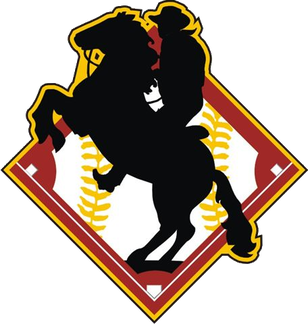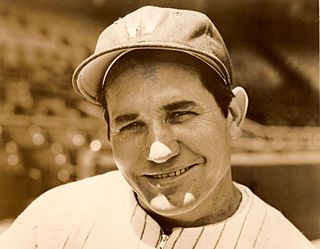Havana is the capital and largest city of Cuba.

Esteban Enrique "Steve" Bellán, was a Cuban-American professional baseball player who played as a third baseman for six seasons in the United States, three in the National Association of Base Ball Players (NABBP) from 1868 to 1870, and three in the National Association of Professional Base Ball Players (NAPBBP) from 1871 to 1873. He is credited as the first Latin American born individual to play professional baseball in the USA.

Adolfo Domingo De Guzmán "Dolf" Luque was a Cuban starting pitcher in Major League Baseball (MLB) from 1914 to 1935. Luque was enshrined in the Cuban Baseball Hall of Fame in 1957 and the Cincinnati Reds Hall of Fame in 1967, as well as in the Mexican Baseball Hall of Fame in 1985. Luque was not only the first White Hispanic pitcher in MLB, but also the first to win a World Series victory, and the first to lead the Leagues in wins and shutouts.

The Estadio Latinoamericano is a stadium in Havana, Cuba. It is primarily used for baseball, and is the second largest baseball stadium in the world by capacity. Gran Estadio, a spacious pitchers' park with prevailing winds blowing in and boasting a playing surface and lighting system of major-league quality, was built in 1946 as the top baseball park in Latin America. Located in the Cerro neighborhood, it opened with the name Gran Estadio de La Habana and currently holds about 55,000 people. In 1999, it also hosted an exhibition series between the Cuba national team and the Baltimore Orioles.

Miguel Angel González Cordero was a Cuban catcher, coach and interim manager in American Major League Baseball during the first half of the 20th century. Along with Adolfo Luque, González was one of the first Cubans or Latin Americans to have a long off-field career in the U.S. Major Leagues.
The Cuban League was one of the earliest and longest lasting professional baseball leagues outside the United States, operating in Cuba from 1878 to 1961. The schedule usually operated during the winter months, so the league was sometimes known as the "Cuban Winter League." It was always a small league, generally 3 to 5 teams, and was centered in Havana, though it sometimes included teams from outlying cities such as Matanzas or Santa Clara. The league became racially integrated in 1900, and during the first half of the 20th century the Cuban League was a premier venue for black and white players to meet. Many great black Northern American players competed in Cuba alongside native black and white Cuban stars such as José Méndez, Cristóbal Torriente, Adolfo Luque, and Martín Dihigo. After 1947, the Cuban League entered into an agreement with Major League Baseball and was used for player development. Following the 1959 Cuban Revolution, however, tensions rose with the new Communist government, and in March 1961 the government decreed the abolition of professional baseball.
The Cuban baseball league system is not a single baseball league; rather it is a structure of leagues and series that are governed by the Baseball Federation of Cuba and culminate in national championships and the selection of the Cuba national baseball team.

The Habana B.B.C. also known as the Habana Reds or, later, the Leones del Habana was one of the oldest and most distinguished baseball teams in the old Cuban League, which existed from 1878 to 1961. Habana, representing the city of Havana, was the only team to play in the league every season of its existence and was one of its most successful franchises. In their early history they were known by their colors as the Reds; later they adopted the names of Leones or Lions. Throughout their existence they had a famous rivalry with Almendares.

The Almendares B.B.C., also known as the Alacranes del Almendares, was one of the oldest and most distinguished baseball teams in the old Cuban League, which existed from 1878 to 1961. Almendares represented the Almendares District on the outskirts of the old city of Havana—when the league was founded it was still considered a suburban area, but later became a district within the enlarged city. Almendares was one of the most successful franchises in the Cuban League. In their early history they were known by their colors as the Blues; later they adopted the name of Alacranes. Throughout their existence they had a famous rivalry with the Habana baseball club.

Vaqueros de la Habana, commonly referred to simply as La Habana, were a baseball team in the Cuban National Series from the 1977–78 season through the 2010–11 season.

Baseball was popularized in Cuba by Nemesio Guillot, who founded the first major baseball club in the country. It became the most played sport in the country in the 1870s, before the period of American intervention.

The Cuban National Series is the primary domestic baseball competition in Cuba. Formed after the dissolution of the Cuban League in the wake of the Cuban Revolution, the National Series is a part of the Cuban baseball league system. Between 1961 and 2021, it was the top-level winter league in Cuba; it now operates as a summer league, with the top six National Series teams qualifying for the Cuban Elite League.
The 17th season of the Cuban National Series saw Vegueros of Pinar del Río Province win the title, finishing with a slim lead over Industriales of Havana. The makeup of the league was directly influenced by the administrative restructuring of the provinces of Cuba. The league expanded from 14 to 18 teams, and the regular season increased from 39 to 51 games.

Yulieski González Ledesma is a pitcher for the Cuba national baseball team and Habana of the Cuban National Series.

Yadier Pedroso González, born in Guanajay, Havana Province, Cuba, was a right-handed pitcher for the Cuban national baseball team and La Habana of the Cuban National Series. Pedroso was part of the Cuban team at the 2006 and 2013 World Baseball Classics.

Conrado Eugenio Marrero Ramos, nicknamed "Connie", was a Cuban professional baseball pitcher. The right-handed Marrero pitched in Major League Baseball from 1950 to 1954 for the Washington Senators. Marrero made his major league debut when he was 38 years old, and was one of the oldest players in the league throughout the duration of his time in the major leagues. He was a popular star in his native Cuba, where he had a long and successful career in amateur baseball, pitching for Cuba in several Amateur World Series competitions, and playing several excellent seasons with the professional Cuban League and the minor league Havana Cubans. His nicknames in Cuba were "El Guajiro de Laberinto", reflecting his rural origins, "El Premier", and "El Curvo."
The American Series was a set of baseball games played between Cuban and American teams in Cuba. An American team would travel to Cuba and play various professional, all-star and/or amateur Cuban teams throughout the country. The series usually took place either in the fall, after the end of the American season, or during spring training before the season began. The first American Series took place in 1879, with then minor league Worcester team going 2–0 against its Cuban opponents.
The Marianao baseball club played in the Cuban Professional League from the 1922–1923 season through to the 1960–1961 season. The club represented the populous town of Marianao in Havana and played their games at La Tropicana Stadium, official site of the league.

Andrés Fleitas [flei'-tasz] was a professional Cuban baseball catcher and first baseman. Listed at 5' 11", 175 lb., he batted and threw right handed.

Eleno Agapito Mayor Valenzuela was a Cuban professional baseball pitcher. Listed at 5' 11", 185 lb., he batted and threw left handed.












